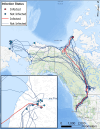Potential impacts of 2.3.4.4b highly pathogenic H5N1 avian influenza virus infection on Snow Goose (Anser caerulescens) movement ecology
- PMID: 40720487
- PMCID: PMC12303340
- DOI: 10.1371/journal.pone.0328149
Potential impacts of 2.3.4.4b highly pathogenic H5N1 avian influenza virus infection on Snow Goose (Anser caerulescens) movement ecology
Abstract
While wild waterfowl are known reservoirs of avian influenza viruses and facilitate the movement of these viruses, there are notable differences in the response to infection across species. This study explored differential responses to infection with highly pathogenic avian influenza in Snow Geese (Anser caerulescens) located in the California Central Valley. Though H5 antibody prevalence was high across years among birds sampled in the winter (75% in both years via hemagglutination inhibition), these values were even higher among birds sampled in summer that failed to migrate (i.e., August 2023 = 100% and August 2024 = 93% via hemagglutination inhibition). Birds that failed to migrate were also generally lighter than birds sampled in the winter and presented notable damage to cerebrum and cerebellum. In December 2022, a single individual positive for infection with H5N1 at the time of sampling indicated reduced movement during the 14 days following sampling but completed spring migration comparably with uninfected conspecifics. However, while no birds were actively infected during sampling and marking in 2023, two marked geese departed for migration late and one did not migrate at all. Additional banded birds marked in August have been reencountered in scenarios ranging from hunter harvest at a different site over a year later to found dead shortly after banding. Our data indicate that Snow Geese infected with HPAI have the potential to express variable outcomes following infection with highly pathogenic H5N1, ranging from rapid recovery within a migratory season to death. These data also suggest that the abnormal failure of some Snow Geese to migrate from the Central Valley is likely driven by HPAI infection.
Copyright: This is an open access article, free of all copyright, and may be freely reproduced, distributed, transmitted, modified, built upon, or otherwise used by anyone for any lawful purpose. The work is made available under the Creative Commons CC0 public domain dedication.
Conflict of interest statement
The authors have declared that no competing interests exist.
Figures






Similar articles
-
Perpetuation of Avian Influenza from Molt to Fall Migration in Wild Swan Geese (Anser cygnoides): An Agent-Based Modeling Approach.Viruses. 2025 Jan 30;17(2):196. doi: 10.3390/v17020196. Viruses. 2025. PMID: 40006951 Free PMC article.
-
Highly Pathogenic Avian Influenza Virus H5N1 in Double-crested Cormorants (Nannopterum auritum) of the Chesapeake Bay, USA.J Wildl Dis. 2025 Apr 1;61(2):348-356. doi: 10.7589/JWD-D-24-00111. J Wildl Dis. 2025. PMID: 39911059
-
Comparative pathogenicity of three A(H5N1) clade 2.3.4.4b HPAI viruses in blue-winged teal and transmission to domestic poultry.mSphere. 2025 Jun 25;10(6):e0002125. doi: 10.1128/msphere.00021-25. Epub 2025 May 22. mSphere. 2025. PMID: 40401902 Free PMC article.
-
The Black Book of Psychotropic Dosing and Monitoring.Psychopharmacol Bull. 2024 Jul 8;54(3):8-59. Psychopharmacol Bull. 2024. PMID: 38993656 Free PMC article. Review.
-
Highly pathogenic avian influenza (H5N1): pathways of exposure at the animal-human interface, a systematic review.PLoS One. 2011 Jan 24;6(1):e14582. doi: 10.1371/journal.pone.0014582. PLoS One. 2011. PMID: 21283678 Free PMC article.
References
MeSH terms
Substances
Grants and funding
LinkOut - more resources
Full Text Sources
Medical

